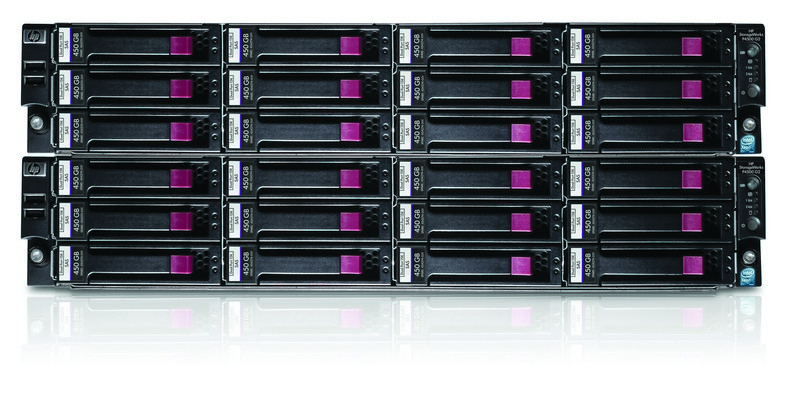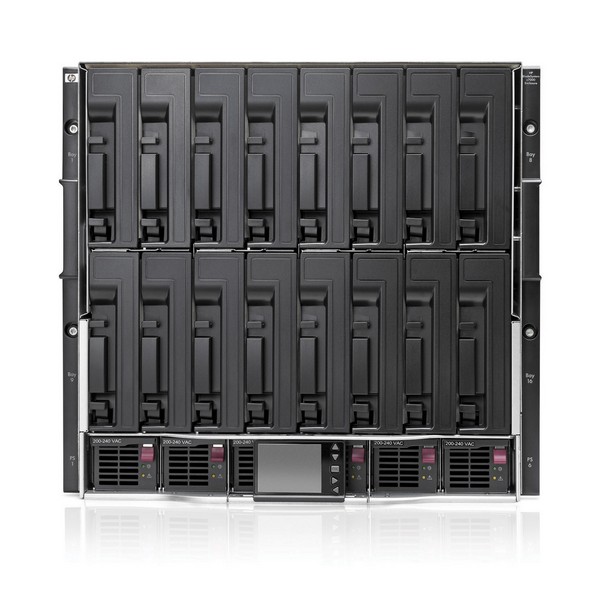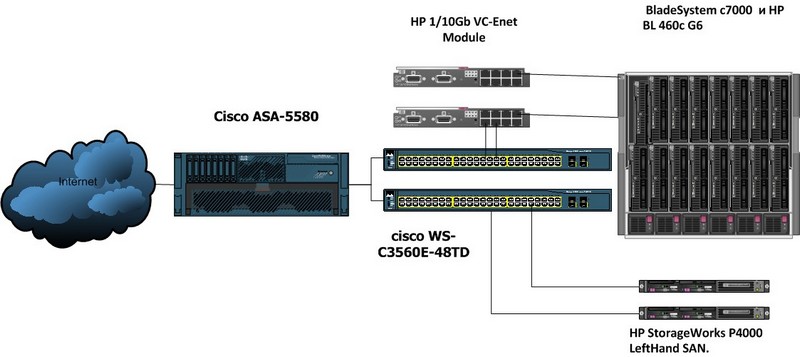Scalable virtual complex based on VMware vSphere
A couple of months ago, we developed and started the launch of a new service for full-fledged operation, capable of replacing the familiar and already slightly conservative leasing of dedicated-servers. The service is based on flexibly scalable provision of computing power and disk space based on hardware from the HP blade system and HP Lefthand storage system. We really wanted to give the service a talking name, and in the end we settled on the combination of “Scalable Virtual Complex”, or, for short, MVK.
For a short time, the MVK proved to be quite a promising project, so we decided to talk about it in more detail.

')
MVK's main task is to be a “cloud with a manual gearbox”. Cloud hosting is certainly one of the main technologies of recent times, but many projects do not need its capabilities, and can’t afford it. Well, there is a specificity, of course. In the near future, we expect to reveal some nuances in conjunction with HP specialists. For now, MVK differs from the classic “cloud” in that the amount of allocated computing power is regulated manually. This allows you to save a lot on the development of its own software implementation of the "cloud", or third-party procurement.
If you briefly describe the process of work - it looks like this. The consumer of the service orders a certain amount of processor power, RAM and disk space. As soon as something starts to be missed, he orders more. Well, it is easy to get rid of the excess, although, of course, we count only on growth. Computational power is calculated in megahertz. We understand that the criterion is quite controversial, but no one has yet come up with more clearly. Do not take FLOPSy, in fact! With RAM and disk space is much easier, here are used the classic gibabytes and terabytes.


The hardware platform for MVK is the HP Bladesystem c7000 Blade Platform. Why blades? Excellent high-speed interconnect, high density and computational power against the background of relatively low power consumption and space in the rack. These are the main arguments for. Taken together, these capabilities of the system are perfectly suited to the application that we intended for it. For those interested in technical details, let us know. The HP BL 460c G6 servers with Intel Xeon 5570 quad-core processors (clock frequency 2.93 GHz) are installed in the “basket”. Each blade supports up to 96 GB of RAM, which, obviously, also plays a role. Separately, I would like to note that the BladeSystem 7000 was very successful in terms of cooling: the system effectively cools all installed blades, regardless of their number. Again, power supplies and cooling modules are redundant, and a high level of fault tolerance is one of the key components of the service.

A few words about the storage system, storage. We use HP StorageWorks P4000 LeftHand. Not least because it works great in tandem with the BladeSystem c7000. Well, the price-opportunity ratio, of course, works in favor of choosing this particular system. For example, the P4000 allows you to configure two storages in a failover cluster, which is exchanged over a fast iSCSI bus. An additional bonus is the fact that, within the storage itself, high-speed SAS disks are built into a RAID level 5 array. This greatly increases the speed of data exchange: the overall system is quite smart, in order to get a comparable out-of-box speed, you will need to spend much more money. Moreover, we have provided another level of redundancy - the “shelves” themselves are also combined into a RAID array.
The VMW vSphere 4 operating system acts as the software main MSC. Being already “run-in” product, it easily builds high-availability clusters, differentiates access rights to virtual machines, uses different types of storage systems with different interfaces, organizes VLAN, makes snapshots install various types of operating systems. In principle, this is quite enough for all aspects of the work of the IAC. In addition, vSphere 4 has a centralized management console. With it, clients can independently manage virtual machines, install operating systems or create disk images, install and configure the necessary software. Well, large projects can even build their own system at the facilities of the MVK and manage it by their own specialists.

VMware vSphere 4 is installed on each blade server. High availability clusters are organized using the management console. All virtual machine data is stored in LeftHand storage and transferred in both directions via the iSCSI interface. Network packets pass to the Internet through the Cisco ASA-5580 hardware traffic filtering system.
The main advantage of using MVK over dedicated-servers or working with its own server hardware is a much higher level of fault tolerance at a comparable price. All data in the system and its hardware elements are duplicated, which virtually eliminates the possibility of failures and loss of performance. At the same time, the flexibility of organizing and increasing the computing power is higher, if not by orders of magnitude, then at least several times. Instead of installing additional servers and messing with setting them up, or stopping work and carrying out an upgrade, the user can simply order additional capacities for his virtual machine and receive them in the shortest period of time.
Of course, MVK can not be in the flexibility and breadth of opportunities with a full cloud hosting. This service is focused on a different audience, on projects that may not have the largest scale, but operate with valuable data and are demanding for the fault tolerance of the hosting platform. The main focus is on banking and retail companies. On the one hand, they do not have such attendance jumps as large information resources (the main clients of cloud hosting), and on the other hand, they have high requirements for fault tolerance and redundancy of their own systems. At the facilities of the MVK, they can deploy a full-fledged copy of their own system and resort to it only in case of failures. Requirements for the work of banks, especially international ones, often include such items, and building your own duplicate system will be much more expensive than using an existing solution.
The material used photos HP Brand Resource Center.
For a short time, the MVK proved to be quite a promising project, so we decided to talk about it in more detail.

')
MVK's main task is to be a “cloud with a manual gearbox”. Cloud hosting is certainly one of the main technologies of recent times, but many projects do not need its capabilities, and can’t afford it. Well, there is a specificity, of course. In the near future, we expect to reveal some nuances in conjunction with HP specialists. For now, MVK differs from the classic “cloud” in that the amount of allocated computing power is regulated manually. This allows you to save a lot on the development of its own software implementation of the "cloud", or third-party procurement.
If you briefly describe the process of work - it looks like this. The consumer of the service orders a certain amount of processor power, RAM and disk space. As soon as something starts to be missed, he orders more. Well, it is easy to get rid of the excess, although, of course, we count only on growth. Computational power is calculated in megahertz. We understand that the criterion is quite controversial, but no one has yet come up with more clearly. Do not take FLOPSy, in fact! With RAM and disk space is much easier, here are used the classic gibabytes and terabytes.
Hardware


The hardware platform for MVK is the HP Bladesystem c7000 Blade Platform. Why blades? Excellent high-speed interconnect, high density and computational power against the background of relatively low power consumption and space in the rack. These are the main arguments for. Taken together, these capabilities of the system are perfectly suited to the application that we intended for it. For those interested in technical details, let us know. The HP BL 460c G6 servers with Intel Xeon 5570 quad-core processors (clock frequency 2.93 GHz) are installed in the “basket”. Each blade supports up to 96 GB of RAM, which, obviously, also plays a role. Separately, I would like to note that the BladeSystem 7000 was very successful in terms of cooling: the system effectively cools all installed blades, regardless of their number. Again, power supplies and cooling modules are redundant, and a high level of fault tolerance is one of the key components of the service.

A few words about the storage system, storage. We use HP StorageWorks P4000 LeftHand. Not least because it works great in tandem with the BladeSystem c7000. Well, the price-opportunity ratio, of course, works in favor of choosing this particular system. For example, the P4000 allows you to configure two storages in a failover cluster, which is exchanged over a fast iSCSI bus. An additional bonus is the fact that, within the storage itself, high-speed SAS disks are built into a RAID level 5 array. This greatly increases the speed of data exchange: the overall system is quite smart, in order to get a comparable out-of-box speed, you will need to spend much more money. Moreover, we have provided another level of redundancy - the “shelves” themselves are also combined into a RAID array.
Software part
The VMW vSphere 4 operating system acts as the software main MSC. Being already “run-in” product, it easily builds high-availability clusters, differentiates access rights to virtual machines, uses different types of storage systems with different interfaces, organizes VLAN, makes snapshots install various types of operating systems. In principle, this is quite enough for all aspects of the work of the IAC. In addition, vSphere 4 has a centralized management console. With it, clients can independently manage virtual machines, install operating systems or create disk images, install and configure the necessary software. Well, large projects can even build their own system at the facilities of the MVK and manage it by their own specialists.
Work pattern

VMware vSphere 4 is installed on each blade server. High availability clusters are organized using the management console. All virtual machine data is stored in LeftHand storage and transferred in both directions via the iSCSI interface. Network packets pass to the Internet through the Cisco ASA-5580 hardware traffic filtering system.
The main advantage of using MVK over dedicated-servers or working with its own server hardware is a much higher level of fault tolerance at a comparable price. All data in the system and its hardware elements are duplicated, which virtually eliminates the possibility of failures and loss of performance. At the same time, the flexibility of organizing and increasing the computing power is higher, if not by orders of magnitude, then at least several times. Instead of installing additional servers and messing with setting them up, or stopping work and carrying out an upgrade, the user can simply order additional capacities for his virtual machine and receive them in the shortest period of time.
findings
Of course, MVK can not be in the flexibility and breadth of opportunities with a full cloud hosting. This service is focused on a different audience, on projects that may not have the largest scale, but operate with valuable data and are demanding for the fault tolerance of the hosting platform. The main focus is on banking and retail companies. On the one hand, they do not have such attendance jumps as large information resources (the main clients of cloud hosting), and on the other hand, they have high requirements for fault tolerance and redundancy of their own systems. At the facilities of the MVK, they can deploy a full-fledged copy of their own system and resort to it only in case of failures. Requirements for the work of banks, especially international ones, often include such items, and building your own duplicate system will be much more expensive than using an existing solution.
The material used photos HP Brand Resource Center.
Source: https://habr.com/ru/post/92908/
All Articles